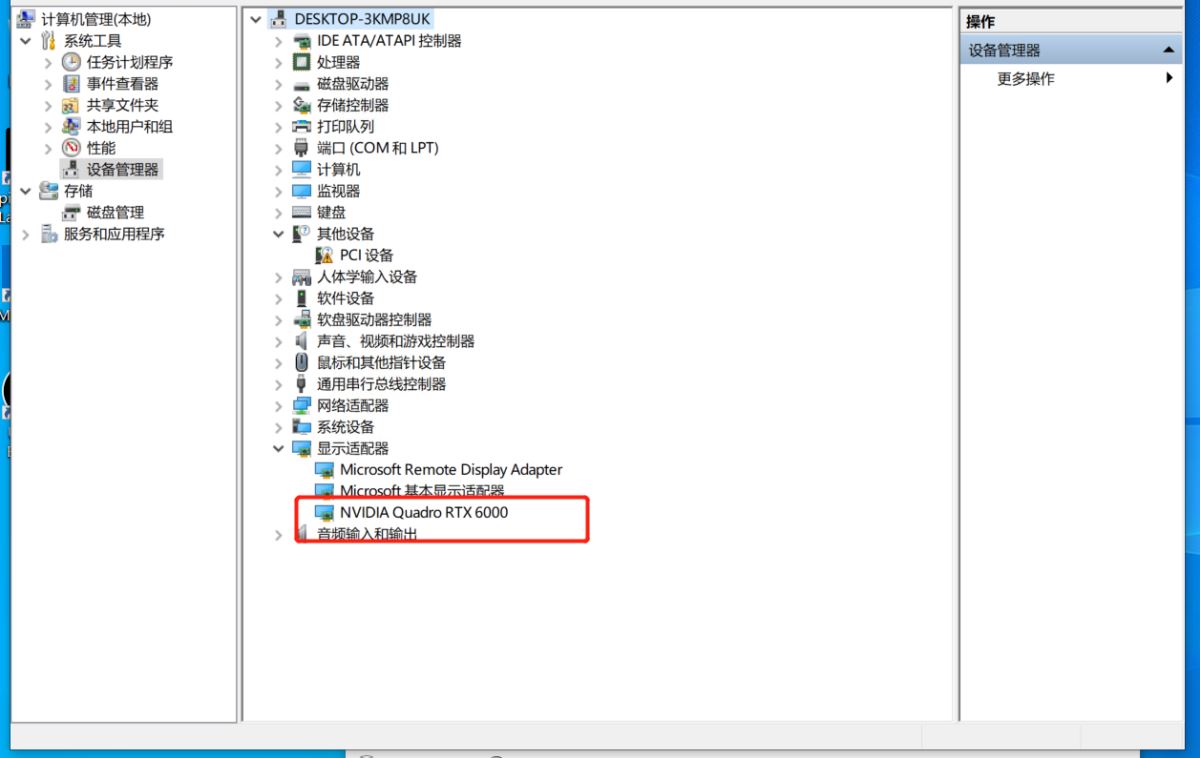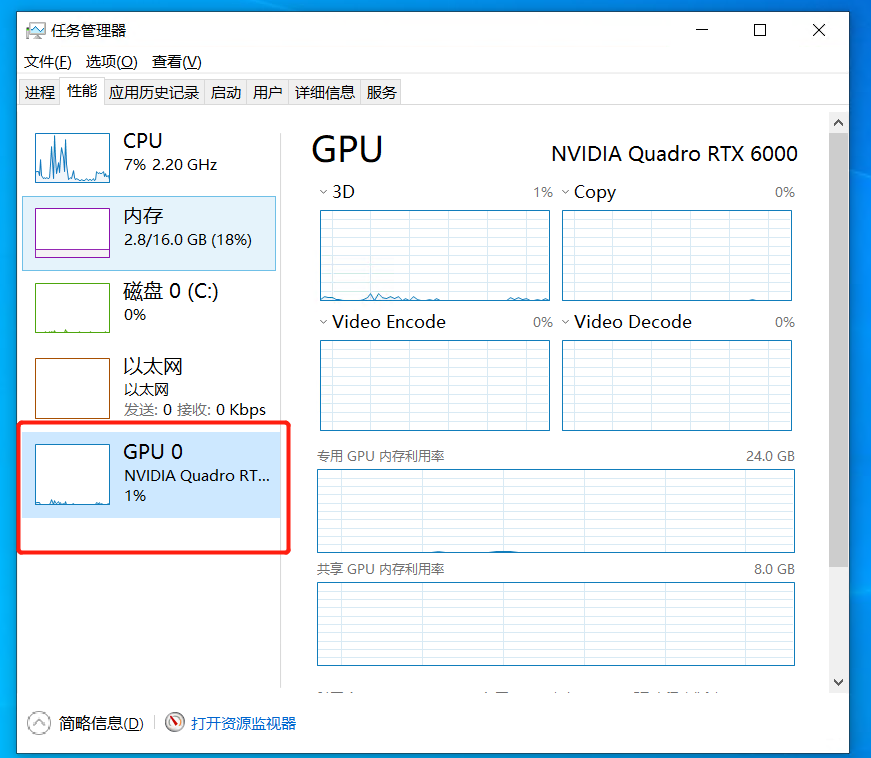kvm 透传显卡win10虚拟机
lixinliang 人气:0环境
已安装nvidia 显卡 驱动 操作系统:CentOS Linux release 7.9.2009 (Core) 内核版本:Linux 5.4.135-1.el7.elrepo.x86_64 显卡 型号:rtx 6000 kvm版本: virsh version Compiled against library: libvirt 4.5.0 Using library: libvirt 4.5.0 Using API : QEMU 4.5.0 Running hypervisor: QEMU 1.5.3
解绑GPU 设备
1.配置GRUB_CMDLINE_LINUX(实测,有效),查询要解绑的设备,记录设备id号
lspci -nn|grep NVIDIA |grep VGA 或者 lspci -nn|grep NVIDIA

2.修改 /etc/default/grub文件的GRUB_CMDLINE_LINUX
vi /etc/default/grub 以下是内容,新增加 GRUB_CMDLINE_LINUX行: intel_iommu=on pci-stub.ids=10de:1e30" GRUB_TIMEOUT=5 GRUB_DISTRIBUTOR="$(sed 's, release .*$,,g' /etc/system-release)" GRUB_DEFAULT=saved GRUB_DISABLE_SUBMENU=true GRUB_TERMINAL_OUTPUT="console" GRUB_CMDLINE_LINUX="intel_iommu=on crashkernel=auto spectre_v2=retpoline rhgb quiet rdblacklist=nouveau pci-stub.ids=10de:1e30" GRUB_DISABLE_RECOVERY="true"
3.更新grub2 conf,执行如下命令
grub2-mkconfig -o /boot/grub2/grub.cfg
4.重启系统
reboot
验证并查看nvidia 显卡
1.执行nvidia-smi ,看不到显卡,证明显卡已经被解绑
# nvidia-smi NVIDIA-SMI has failed because it couldn't communicate with the NVIDIA driver. Make sure that the latest NVIDIA driver is installed and running.
2.验证内核支持iommu
cat /proc/cmdline | grep iommu 结果输出: intel_iommu=on

3.验证VT-D是否启用
dmesg |grep -e DMAR -e IOMMU

安装win10虚拟机
qemu-img create -f qcow2 /home/kvm-machines/shaoyan.qcow2 200G virt-install --name shaoyan --ram 4096 --vcpus=8 --os-type=windows --accelerate --cdrom=/home/kvm_images/win10.iso --disk path=/home/kvm-machines/shaoyan.qcow2,format=qcow2,bus=ide --bridge=br0 --autostart --vnc --vncport=5910 --vnclisten=0.0.0.0
宿主机安装软件包
yum -y groups install 'GNOME Desktop' virt-manager virt-viewer dejavu-lgc-sans-fonts
显卡加载vfio驱动
1.显卡加载vfio驱动
modprobe vfio modprobe vfio-pci
2.从服务器卸载1张显卡的4个设备
virsh nodedev-detach pci_0000_b1_00_0 virsh nodedev-detach pci_0000_b1_00_1 virsh nodedev-detach pci_0000_b1_00_2 virsh nodedev-detach pci_0000_b1_00_3
3.验证显卡设备是否加载vfio-pci驱动,加载成功
# lspci -vv -s b1:00.0 | grep driver
Kernel driver in use: vfio-pci
[root@rtx_6000 10.147.100.107 ~ ]
# lspci -vv -s b1:00.1 | grep driver
Kernel driver in use: vfio-pci
[root@rtx_6000 10.147.100.107 ~ ]
# lspci -vv -s b1:00.2 | grep driver
Kernel driver in use: vfio-pci
[root@rtx_6000 10.147.100.107 ~ ]
# lspci -vv -s b1:00.3 | grep driver
Kernel driver in use: vfio-pciwin10虚拟机添加NVDIA显卡
1.通过远控卡登录服务器透传显卡,执行startx 调出可视化页面
startx
2.添加显卡硬件

3.查看显卡

显卡驱动安装
1.要安装显卡驱动,需要修改虚拟机win10的配置文件 否则显卡驱动安装过程中自检会报错ERROR CODE 43,驱动不允许安装在虚拟机上。
#编辑VM XML virsh edit shaoyan #修改第一行 <domain type='kvm'> #为 <domain type='kvm' xmlns:qemu='http://libvirt.org/schemas/domain/qemu/1.0'> #找到<features>节点,添加内容 <features> ... <kvm><hidden state='on'/></kvm> ... </features> #找到</device>节点,在device后添加内容 <qemu:commandline><qemu:arg value='-cpu'/><qemu:arg value='host,hv_time,kvm=off,hv_vendor_id=null'/> </qemu:commandline> #重启VM virsh destroy shaoyan virsh start shaoyan
2.附录完整xml 文件如下,如果是拷贝至其他宿主机配置文件的话,只需要保留xml 文件中的第一组hostdev即可,否则会报错
# cat /etc/libvirt/qemu/shaoyan.xml
<!--
WARNING: THIS IS AN AUTO-GENERATED FILE. CHANGES TO IT ARE LIKELY TO BE
OVERWRITTEN AND LOST. Changes to this xml configuration should be made using:
virsh edit shaoyan
or other application using the libvirt API.
-->
<domain type='kvm'>
<name>shaoyan</name>
<uuid>e06c6c3b-0a57-43e8-9d6f-02fd1e2aad83</uuid>
<title>gpu</title>
<description>gpu</description>
<memory unit='KiB'>16777216</memory>
<currentMemory unit='KiB'>16777216</currentMemory>
<vcpu placement='static'>16</vcpu>
<os>
<type arch='x86_64' machine='pc-i440fx-rhel7.0.0'>hvm</type>
<boot dev='hd'/>
</os>
<features>
<acpi/>
<apic/>
<hyperv>
<relaxed state='on'/>
<vapic state='on'/>
<spinlocks state='on' retries='8191'/>
</hyperv>
</features>
<cpu mode='host-passthrough' check='none'/>
<clock offset='localtime'>
<timer name='rtc' tickpolicy='catchup'/>
<timer name='pit' tickpolicy='delay'/>
<timer name='hpet' present='no'/>
<timer name='hypervclock' present='yes'/>
</clock>
<on_poweroff>destroy</on_poweroff>
<on_reboot>restart</on_reboot>
<on_crash>destroy</on_crash>
<pm>
<suspend-to-mem enabled='no'/>
<suspend-to-disk enabled='no'/>
</pm>
<devices>
<emulator>/usr/bin/qemu-kvm</emulator>
<disk type='file' device='disk'>
<driver name='qemu' type='qcow2'/>
<source file='/data/kvm/shaoyan.qcow2'/>
<target dev='hda' bus='ide'/>
<address type='drive' controller='0' bus='0' target='0' unit='0'/>
</disk>
<controller type='usb' index='0' model='ich9-ehci1'>
<address type='pci' domain='0x0000' bus='0x00' slot='0x04' function='0x7'/>
</controller>
<controller type='usb' index='0' model='ich9-uhci1'>
<master startport='0'/>
<address type='pci' domain='0x0000' bus='0x00' slot='0x04' function='0x0' multifunction='on'/>
</controller>
<controller type='usb' index='0' model='ich9-uhci2'>
<master startport='2'/>
<address type='pci' domain='0x0000' bus='0x00' slot='0x04' function='0x1'/>
</controller>
<controller type='usb' index='0' model='ich9-uhci3'>
<master startport='4'/>
<address type='pci' domain='0x0000' bus='0x00' slot='0x04' function='0x2'/>
</controller>
<controller type='pci' index='0' model='pci-root'/>
<controller type='ide' index='0'>
<address type='pci' domain='0x0000' bus='0x00' slot='0x01' function='0x1'/>
</controller>
<interface type='bridge'>
<mac address='52:54:00:48:b2:5a'/>
<source bridge='br0'/>
<model type='e1000'/>
<address type='pci' domain='0x0000' bus='0x00' slot='0x03' function='0x0'/>
</interface>
<serial type='pty'>
<target type='isa-serial' port='0'>
<model name='isa-serial'/>
</target>
</serial>
<console type='pty'>
<target type='serial' port='0'/>
</console>
<input type='tablet' bus='usb'>
<address type='usb' bus='0' port='1'/>
</input>
<input type='mouse' bus='ps2'/>
<input type='keyboard' bus='ps2'/>
<graphics type='vnc' port='5910' autoport='no' listen='0.0.0.0'>
<listen type='address' address='0.0.0.0'/>
</graphics>
<video>
<model type='vga' vram='16384' heads='1' primary='yes'/>
<address type='pci' domain='0x0000' bus='0x00' slot='0x02' function='0x0'/>
</video>
<hostdev mode='subsystem' type='pci' managed='yes'>
<source>
<address domain='0x0000' bus='0xb1' slot='0x00' function='0x0'/>
</source>
<address type='pci' domain='0x0000' bus='0x00' slot='0x06' function='0x0'/>
</hostdev>
<hostdev mode='subsystem' type='pci' managed='yes'>
<source>
<address domain='0x0000' bus='0xb1' slot='0x00' function='0x1'/>
</source>
<address type='pci' domain='0x0000' bus='0x00' slot='0x07' function='0x0'/>
</hostdev>
<hostdev mode='subsystem' type='pci' managed='yes'>
<source>
<address domain='0x0000' bus='0xb1' slot='0x00' function='0x2'/>
</source>
<address type='pci' domain='0x0000' bus='0x00' slot='0x08' function='0x0'/>
</hostdev>
<hostdev mode='subsystem' type='pci' managed='yes'>
<source>
<address domain='0x0000' bus='0xb1' slot='0x00' function='0x3'/>
</source>
<address type='pci' domain='0x0000' bus='0x00' slot='0x09' function='0x0'/>
</hostdev>
<memballoon model='virtio'>
<address type='pci' domain='0x0000' bus='0x00' slot='0x05' function='0x0'/>
</memballoon>
</devices>
</domain>
3.登录win10 虚拟机配置网络
4.安装驱动,选择具体型号进行下载并安装驱动
https://www.nvidia.cn/Download/index.aspx?lang=cn
5.查看显卡设备


至此,win10通过kvm虚拟化透传GPU 显卡完成!
加载全部内容